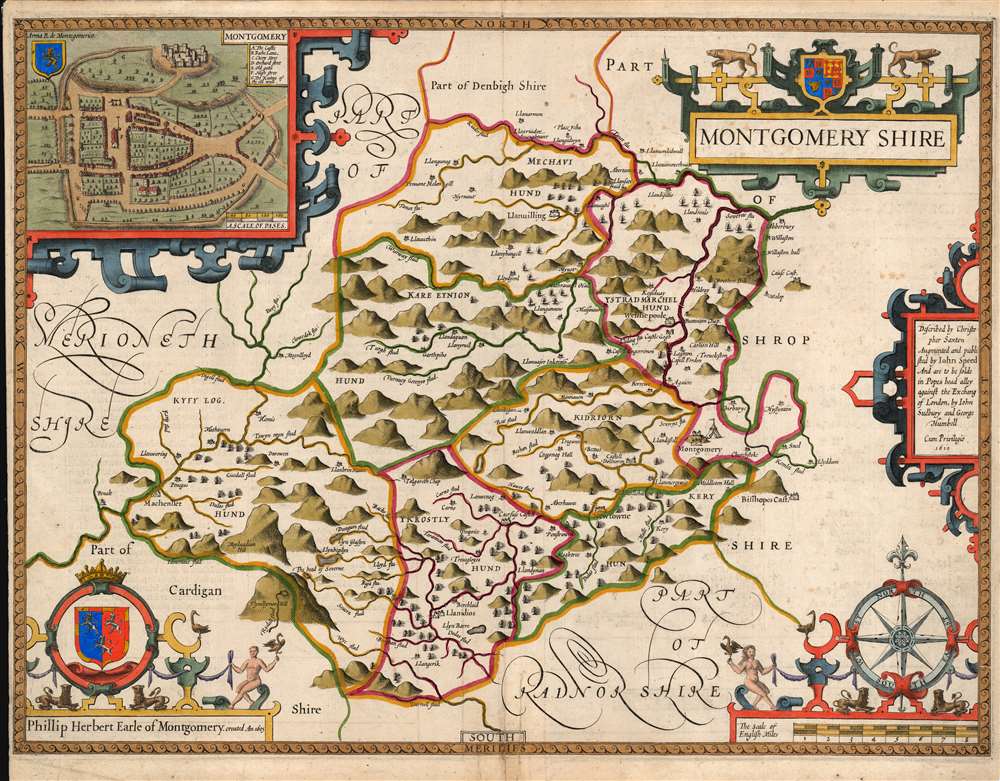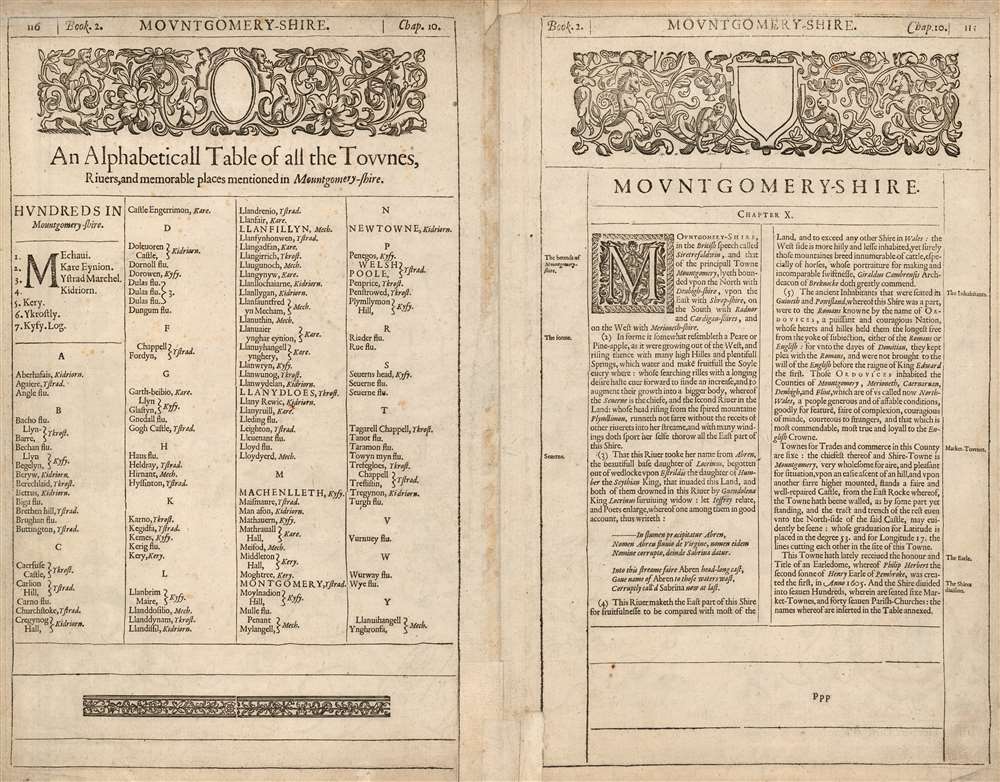1646 John Speed County Map of Montgomeryshire
Montgomeryshire-speed-1646
Title
1646 (dated) 15 x 20 in (38.1 x 50.8 cm) 1 : 138000
Description
An Essential Borderland
Montgomeryshire was an administrative county of Wales, the Lordship of Powys, a key border county between England and Wales. As part of the Laws in Wales Acts, it was converted into an English county. The town of Montgomery represented the center of English authority in the region. That said, the Welsh Cantrevs were frequently at war with one another, and the old walls of Montgomery were ruined in the sack of the town by Owain Glyndŵr in 1402. At the time this map was made, these were still ruined. The 13th century stone castle marked in the city plan survived until a few years after the printing of this map. Montgomeryshire had been royalist during the English Civil War, and was the site of the largest battle in Wales fought during the conflict. In 1649 the castle was deliberately dismantled to make it unusable in any future conflict.Publication History and Census
This map was engraved by Jodocus Hondius in 1610 for inclusion in John Speed's The Theatre of the Empire of Great Britaine published in London by Sudbury and Humble in 1614. It continued in publication in the atlas in all its editions, including those that were bound together with Speed's A Prospect of the Most Famous Parts of the World. This example bears the Sudbury and Humble imprint, and typographically corresponds to 1646 editions of the Prospect. Perhaps sixteen examples of the separate map, in various editions, appear in institutional collections.CartographerS
John Speed (1542 - 1629) was an important English historian and cartographer active in the early 17th century. Speed was born in Fardon, Cheshire and apprenticed under his father as a tailor. Though his heart was never in tailoring, Speed dedicated himself to this profession until he was about 50 years old. During all the time, Speed dedicated his spare time to research as amateur historian and mapmaker - even preparing several maps for Queen Elizabeth. In London, Speed's interest in history lead him to join the Society of Antiquaries. Eventually he befriended the wealthy Sir Fulke Greville, who sponsored his researches and eventually freed him from the haberdashery profession. Working with William Camden, Speed eventually published his 1611 Historie of Great Britaine. Though this history itself was amateurish and of minimal importance, Speed's inclusion of numerous maps of British Cities and town was seminal. In many cases these plans were the first maps ever issued of their respective subjects. Later, turning his attention more fully to Geography, Speed published the magnificent atlas Theatre of the Empire of Great Britaine and, just prior to his death, the 1627 A Prospect of the Most Famous Parts of the World. These were the first British world atlases and have a landmark position in the history of cartography. These atlases continued to be published well after Speed's death. More by this mapmaker...
Jodocus Hondius (October, 14 1563 - February 12, 1612) was an important Dutch cartographer active in the late 16th and early 17th centuries. His common name, Jodocus Hondius is actually a Latinized version of his Dutch name, Joost de Hondt. He is also sometimes referred to as Jodocus Hondius the Elder to distinguish him from his sons. Hondius was a Flemish artist, engraver, and cartographer. He is best known for his early maps of the New World and Europe, for re-establishing the reputation of the work of Gerard Mercator, and for his portraits of Francis Drake. Hondius was born and raised in Ghent. In his early years he established himself as an engraver, instrument maker and globe maker. In 1584 he moved to London to escape religious difficulties in Flanders. During his stay in England, Hondius was instrumental in publicizing the work of Francis Drake, who had made a circumnavigation of the world in the late 1570s. In particular, in 1589 Hondius produced a now famous map of the cove of New Albion, where Drake briefly established a settlement on the west coast of North America. Hondius' map was based on journal and eyewitness accounts of the trip and has long fueled speculation about the precise location of Drake's landing, which has not yet been firmly established by historians. Hondius is also thought to be the artist of several well-known portraits of Drake that are now in the National Portrait Gallery in London. In 1593, Hondius returned to Amsterdam, where he remained until the end of his life. In 1604, he purchased the plates of Gerard Mercator's Atlas from Mercator's grandson. Mercator's work had languished in comparison to the rival atlas, Theatrum Orbis Terrarum by Ortelius. Hondius republished Mercator's work with 36 additional maps, including several which he himself produced. Despite the addition of his own contributions, Hondius recognizing the prestige of Mercator's name, gave Mercator full credit as the author of the work, listing himself as the publisher. Hondius' new edition of Mercator revived the great cartographer's reputation and was a great success, selling out after a year. Hondius later published a second edition, as well as a pocket version called the Atlas Minor. The maps have since become known as the "Mercator/Hondius series". Between 1605 and 1610 Hondius was employed by John Speed to engrave the plates for Speed's The Theatre of the Empire of Great Britaine. Following Hondius' death in 1612, his publishing work in Amsterdam was continued by his widow and two sons, Jodocus II and Henricus. Later his family formed a partnership with Jan Jansson, whose name appears on the Atlasas co-publisher after 1633. Eventually, starting with the first 1606 edition in Latin, about 50 editions of the Atlas were released in the main European languages. In the Islamic world, the atlas was partially translated by the Turkish scholar Katip Çelebi. The series is sometimes called the 'Mercator/Hondius/Jansson' series because of Jansson's later contributions. Hondius' is also credited with a number of important cartographic innovations including the introduction of decorative map borders and contributions to the evolution of 17th century Dutch wall maps. The work of Hondius was essential to the establishment Amsterdam as the center of cartography in Europe in the 17th century. Learn More...
Christopher Saxton (c. 1540 – c. 1610) was an English cartographer. He produced the first county maps of England and Wales. His childhood and education is not well understood but he may have attended the predecessor school to Queen Elizabeth Grammar School, Wakefield and also Cambridge University. It is supposed that he learned mapmaking from John Rudd, the vicar of Dewsbury and Thornhill. He was commissioned to begin a survey of England, financed by Thomas Seckford of Suffolk, Saxton began the work in 1574; in 1577 he extended his survey to Wales. The first plates were engraved in 1574, and they were complete in 1578. The maps were produced in the Atlas of the Counties of England and Wales published in 1579. The atlas was popular and influential; cartographers including John Speed would add to and adapt Saxton's work. Saxton may have engraved the maps of the Welsh counties himself: the remainder of the atlas was engraved by Dutch and Flemish artists. Learn More...




